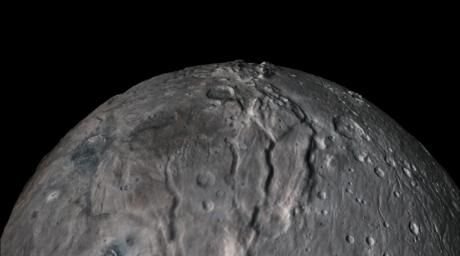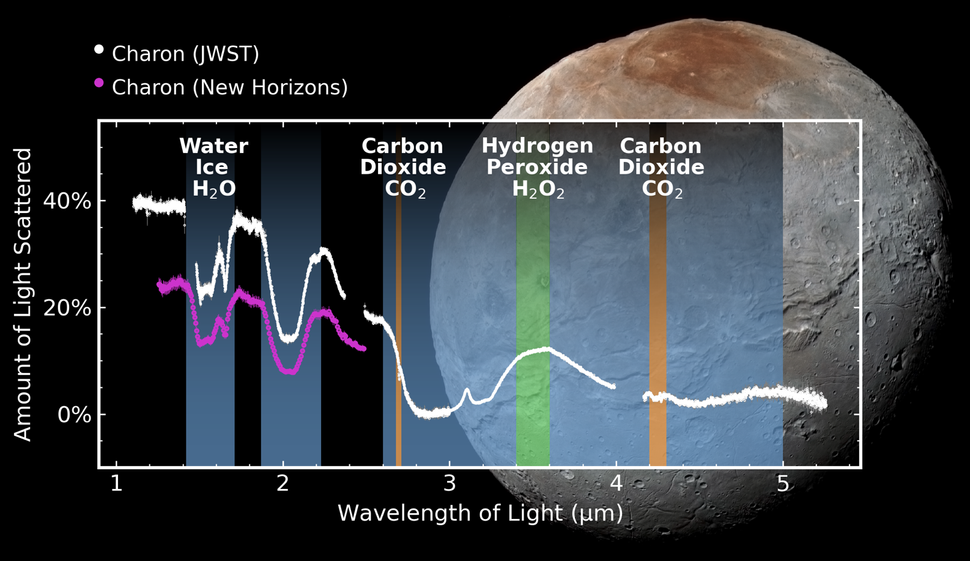Using the powerful James Webb Space Telescope (JWST), scientists have identified previously undetected chemicals on the surface of Charon, Pluto’s largest moon.
The groundbreaking discovery of carbon dioxide and hydrogen peroxide offers new insights into the history and composition of this distant celestial body.
The JWST’s advanced observational capabilities allowed scientists to look below the ice covering Charon’s surface, uncovering these intriguing chemicals.
Before this, NASA’s New Horizons spacecraft had captured images of Charon’s unusual reddish hue during its flyby in 2015, but the detailed chemical analysis was beyond its technical scope.

From 2022 to 2023, the JWST’s Near-Infrared Spectrometer (NIRSpec) was employed to examine Charon’s surface in much greater detail than ever before.
This effort confirmed the presence of not just water ice and organic compounds responsible for the moon’s color, but also carbon dioxide and hydrogen peroxide.
“Webb’s advanced observational abilities allowed the team to study light scattered from Charon’s surface at longer wavelengths, expanding our understanding of this complex object”, explained Ian Wong of the Space Telescope Science Institute, co-author of a new paper in Nature Communications.
The data collected were so precise that the multi-institutional team could hypothesize how these chemicals ended up on Charon’s surface.
According to Silvia Protopapa from the Southwest Research Institute, the carbon dioxide likely originates from the moon’s interior and was brought to the surface through cratering events.
This theory aligns with the known presence of carbon dioxide in the protoplanetary disk from which the Pluto system formed.
Besides the carbon dioxide, the detection of hydrogen peroxide came as a surprise to the scientists.
This chemical seems to have formed through the interaction of ultraviolet solar light with energetic particles from cosmic rays.
Experiments conducted by the team showed that hydrogen peroxide could indeed form in conditions analogous to those on Charon, even in the presence of carbon dioxide and water ice.

“Our research reveals that Charon’s surface preserves evidence of its formation through the presence of carbon dioxide as well as signs of irradiation processes, indicated by the presence of hydrogen peroxide,” Protopapa said.
Charon, which has been under scrutiny since its discovery in 1978, offers researchers a rare opportunity to study a midsized body located in the Kuiper Belt, a ring of icy debris, comets, and dwarf planets at the solar system’s edge.
Unlike larger Kuiper Belt objects, Charon’s surface lacks volatile ices like methane, making it an invaluable target for studying the effects of sunlight exposure and cratering.
Geologic mapping data from NASA’s New Horizons spacecraft, combined with the JWST’s spectroscopic capabilities, have allowed researchers to better understand the processes shaping Charon’s surface.
This includes the impact events that expose subsurface materials, revealing the moon’s hidden chemical inventory.
Looking ahead, the JWST will continue to study Charon, allowing scientists to gain even more detailed insights into the moon’s composition and the broader category of icy trans-Neptunian objects (TNOs).
Future observations could uncover new chemical compounds and processes at work on this intriguing moon.
The team’s findings, published in Nature Communications, offer valuable insights into the formation and evolution of icy bodies at the outermost edges of our solar system.
As the JWST continues its mission, we can expect even more revelations about distant celestial objects like Charon.
